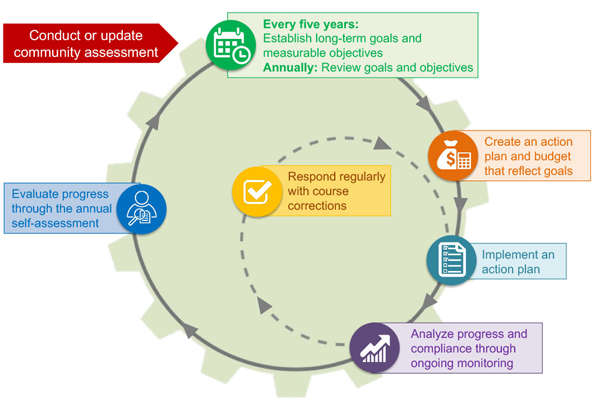 Getting Started
Getting Started
When planning a trip, you typically begin by identifying where you are headed and then determine the best route to get there. A Head Start program’s strategic planning effort also begins by setting a direction. Programs examine relevant program and community data and ask dialogue-generating questions to clarify the direction to take toward strategic goals. With the Head Start planning cycle as their guide, programs can purposefully pursue goals to transform their vision into reality for enrolled children and their families.
Whether you are new to Head Start or updating your knowledge of program planning best practices, consider reading through this topic to extend your understanding of program goals, measurable objectives, expected outcomes, and action plans. This topic also explores the importance of identifying expected challenges.
The terms goals, objectives, outcomes, action plans, and challenges are widely used in the research, evaluation, education, and business communities. The purpose of Topic 1 is to define these terms in the context of Head Start.
These terms and definitions are key to strategic planning and are fundamental to the Head Start grant application process. Both the HSPPS and the Head Start Grant Application Instructions highlight key terminology. Consider how these terms are integral to the program planning cycle.
Head Start Grant Application Instructions Key Terms and Definitions
Program Goals – Broad statements that describe what a program intends to accomplish. Program goals should be strategic, long-term, and responsive to the needs identified in the community assessment.
They include:
- Goals for the provision of educational, health, nutritional, and family and community engagement program services to further promote the school readiness of enrolled children
- School readiness goals
- Effective health and safety practices to ensure children are safe at all times
- Programs may wish to identify these as stand-alone goals or as objectives related to another type of program goal (e.g., a health goal)
School Readiness Goals – The expectations of children's status and progress across domains of language and literacy development, cognition and general knowledge, approaches to learning, physical well-being and motor development, and social and emotional development that will improve their readiness for kindergarten. Terms, 45 CFR § 1305.2
Measurable Objectives – Support the attainment of goals that are Specific, Measurable, Attainable, Realistic, and Timely (SMART).
Progress – Forward movement toward the achievement of goals, objectives, and outcomes.
Outcomes – Something that happened as a result of an activity or process. The actual results achieved.
Challenges – Information describing obstacles to achieving program goals and objectives.
Evidence – Facts, information, documentation, or examples given to support an assertion.
Page 7 of the Head Start Grant Application Instructions (2017–2018) highlights key terms and definitions.
Tell Me More
The Head Start resource Five Steps to Community Assessment guides the development of responsive community assessments.
Effective Head Start1 programs engage in a cyclical planning process. Prior to the first year of the five-year project period, the program’s planning team determines strategic goals that are informed by data and findings from the community assessment, annual self-assessment, and related child, family, and community data. These strategic goals set the course for continuous improvement and innovation. New programs that have not yet conducted an annual self-assessment can use the community assessment to develop long-term goals.

As the program planning cycle shows, programs use the five-year planning process to develop, monitor, and evaluate progress toward strategic long-term goals.
Equipped with this wealth of information, your planning team can affirm or revise the program goals and objectives, keeping in mind that program goals should remain the same wherever possible so it is easier to track progress over time. You may find that some objectives have been accomplished over the course of the year, and now the recommendations of the self-assessment team lead to new objectives, along with next steps to move toward the goal.
 How is the program planning cycle used in your program?
How is the program planning cycle used in your program?
As part of the baseline application, you will identify expected outcomes and document expected challenges. This process is valuable in encouraging your team to adopt a more critical, thorough, and big-picture perspective. And, in turn, having a more comprehensive perspective will lessen the likelihood that your program will need to change goals.
 Learning Objectives
Learning Objectives
Programs understand each of the planning elements in the context of Head Start's planning cycle. Learn how they collectively contribute to successful programming, strategic program goals, and ultimately, positive outcomes for children, their families, and communities.
Additionally, programs can recognize how planning elements, and the process in its entirety, offer a critical platform for identifying challenges to a program’s progress.
1. Throughout this document, the term “Head Start” refers to both Head Start programs and services for children and families.
Read more:
Resource Type: Article
National Centers: Program Management and Fiscal Operations
Audience: Directors and Managers
Last Updated: February 19, 2025
